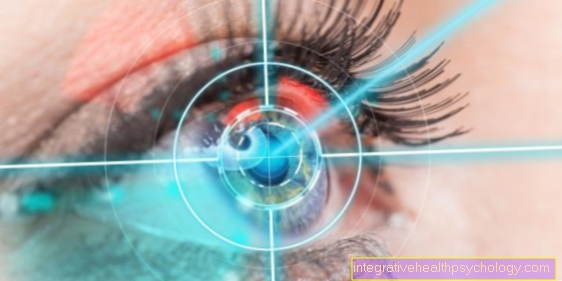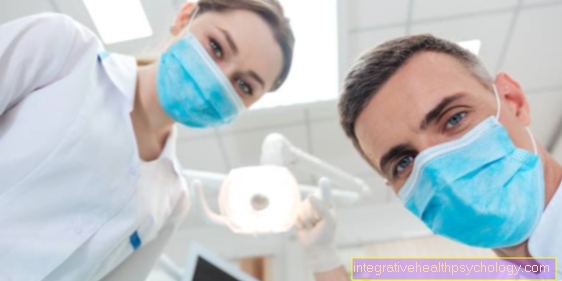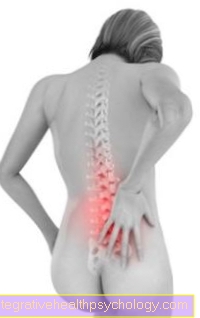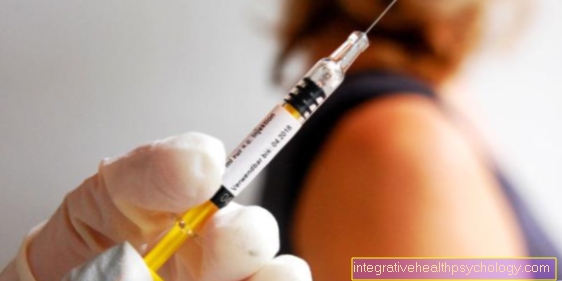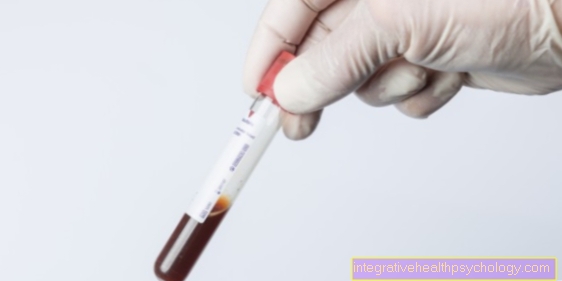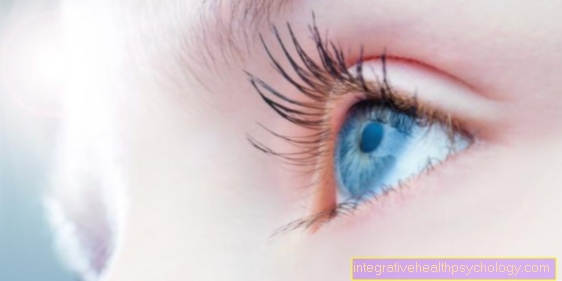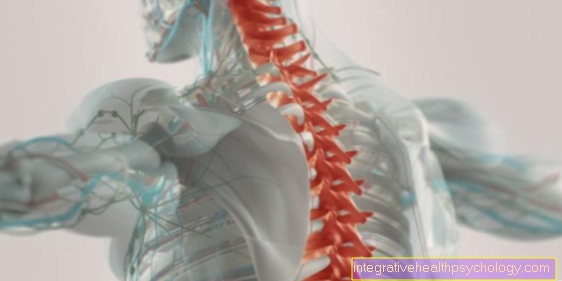Photodynamic Therapy
Synonyms in a broader sense
English: photodynamic therapy
Definition - What is Photodynamic Therapy?
Photodynamic therapy is a procedure that is supposed to have a healing or soothing effect on tumors of the skin and new blood vessels and consists of light irradiation in combination with chemicals.

The method of photodynamic therapy
The idea behind photodynamic therapy is to damage and destroy degenerate cells through exposure to light. Here, the patient is injected with a photosensitizing substance (photosensitizer), which is distributed in the body and mainly accumulates on the affected tumor or skin cells. If it is skin tumors that are to be treated, the sensitizing substance can also be applied to the skin. The enriching and sensitizing substance has the function of a target marker, which is then illuminated by light of different wavelengths (photodynamic therapy). The light also reaches the surrounding tissue, but a reaction only takes place in the previously enriched area. When the light rays meet the photosensitizer, so-called oxygen radicals are generated as a chemical reaction. These then damage the diseased tissue, causing the diseased cells to die (photodynamic therapy)
Application areas of photodynamic therapy
Originally, photodynamic therapy was tested and applied against skin tumors. The main reason was that the emitted light had only a small penetration depth and so the surface of the skin and the tumors there could be safely reached.
Photodynamic Therapy in Dermatology
In addition to various forms of cancer, so-called actinic keratoses, warts and basaliomas, Bowen's disease, spinaliomas, skin T-cell lymphomas, Kaposi's sarcomas, keratoacanthomas, psoriasis vulgaris, human papillomavirus, molluscum contagiosum and acne can be treated with photodynamic therapy.
In dermatology, the sensitizing dye is usually not sprayed but applied to the skin. MAOP is used (Methyl 5-amino 4 oxopentanoate) as a cream. Due to its molecular structure, the substance accumulates particularly heavily in previously damaged tissue. The exposure time is 3 hours. Then the corresponding area is irradiated with a red light. A so-called cold red light with a wavelength of 630 nm is used here (photodynamic therapy).
When the light radiation hits it, oxygen radicals are created, which are released to the correspondingly illuminated tissue. The affected cells ultimately perish through complex biochemical processes. Due to the very specific irradiation, surrounding, healthy tissue is spared, scarring usually does not occur.
If it is not clear at the beginning of a treatment whether photodynamic treatment can help, a sample biopsy is taken and examined first. The actual photodynamic treatment then starts a week later. A period of 3-5 hours must be planned for the first session. The photosensitizing cream is applied about 0.5 to 1 mm thick on the affected area and then sealed with aluminum foil.
The procedure can be carried out on an outpatient basis and patients can often leave the doctor's office during this time. One hour before the radiation starts, the patient must take pain medication. Shortly before the irradiation, a locally numbing pain gel is applied, which is supposed to inhibit the acute pain. Then the irradiation with cold red light begins. After the treatment, the irradiated area is coated with anti-inflammatory and cooling creams. It should also be applied 3-4 times a day in the following days. Cooling bandages can also help alleviate the locally triggered inflammatory reactions.
Photodynamic therapy is also used in the field of anti-aging. Old and e.g. cells damaged by prolonged exposure to sunlight are killed by the radiation. The irradiation time is about 30 minutes. Here, too, the irradiation should be repeated at 10-day intervals (photodynamic therapy).
Photodynamic therapy in ophthalmology
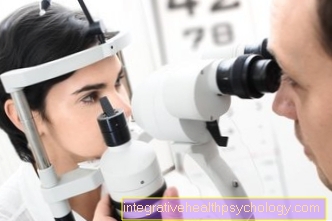
Another area of application is ophthalmology. In the case of so-called age-related macular degeneration, a therapeutic attempt with photodynamic therapy can also be undertaken. This is a relatively new treatment method known as choroidal neovasculation, i.e. pathological neovascularization that often results in macular degeneration.
The dye verteprofin is allowed to run into the patient's vein for 10 minutes. During this time, the dye accumulates in the vascular endothelia of the diseased choroidal vessels and sensitizes them to light. After enrichment, the cells are obliterated with a red, non-thermal laser light over a period of 82 seconds. Since the dye also enriches other areas, i.e. the surrounding area, the treatment must take place in the dark.
During the time after the treatment (photodynamic therapy) there is still dye in the tissue of the eye and the surrounding skin. For this reason, the patient must strictly protect himself from light even after the treatment, wear long sleeves, special sunglasses and should not leave the house. This closed season is recommended for around 48 hours. Ophthalmological examinations are also not allowed to take place during this time.
Photodynamic therapy for actinic keratosis
Actinic keratosis usually describes superficial precursors of skin cancer. These are malignant (malignant) changed cells that can develop into skin cancer within a short time.
The photodynamic therapy can target these cells and prevent the development of real skin cancer. The photodynamic therapy is particularly well suited for large areas of actinic keratosis. Since photodynamic therapy only reaches the superficial cell layers, skin cancer that has already established itself in deep layers of the skin can no longer be prevented with photodynamic therapy.
At this point we recommend that you read the following articles for the most important information regarding actinic keratosis:
- How can actinic keratosis be recognized?
- Actinic Keratosis - What is the Best Therapy?
Photodynamic therapy for basalioma
Photodynamic therapy is not only suitable for skin cancer precursors, in recent years an expanded range of treatments has emerged. Various forms of basalioma (white skin cancer) can now also be treated. However, photodynamic therapy does not reach the deep layers of the skin, so the treatment is only beneficial in the case of a superficial basal cell carcinoma.
Our main article is suitable for additional information on the subject: Basalioma - information on white skin cancer
Duration of application of photodynamic therapy
For the treatment of macular degeneration in ophthalmology, a 2-3 times repetition of the radiation (photodynamic therapy) must be planned. In dermatology, two irradiations are initially carried out. There should be 7-10 days in between.
Photodynamic therapy is so painful
In its early stages, phototherapy has often been described as a painful therapy. In the meantime, the treatment options have been improved so that the pain has given way to a distinct feeling of warmth.
However, if severe symptoms occur during therapy, they can be treated well with painkillers. In addition, painkillers can be administered in advance for the next therapeutic session. In order to reduce the feeling of warmth, the skin can also be cooled in between.
You can also increase the distance to the lamp so that the intensity is no longer so strong. Current developments also show an advantage of daylight therapy over artificial light, as it causes less pain and a feeling of warmth.
Risks and side effects of photodynamic therapy
As with any medical procedure, side effects can occur. With photodynamic therapy in dermatology, these side effects mainly consist of pain, redness, swelling and crusty skin deposits on the affected areas that become detached in the following days. Furthermore, allergic overreactions, wound infections or symptoms of burns can occur. In rare cases, scarring can occur.
After photodynamic therapy, in most cases there is significant swelling and reddening of the irradiated skin. This usually lasts for about one to two weeks. The redness is often uncomfortable after photodynamic therapy and causes symptoms similar to sunburn. Burning or pain can occur in the affected area. However, this skin reaction is deliberate as it indicates that the skin is responding to photodynamic therapy.
In addition, small crusts can develop. These consist of the cells destroyed by the therapy.Therefore, crust formation is also desired. The more crusts that are formed, the more precursors of the cancer cells have been killed. In addition, the treated skin areas can overheat immediately during or after the treatment. In addition, there is a significantly increased sensitivity to light for about 24 to 48 hours, which is why direct sunlight should be avoided.
Hyperpigmentation of the treated area can occur relatively often after the procedure.
In rare cases, nausea and fever can occur in the first time after an application, but this does not require further treatment and has regressed.
It should be noted that no skin-irritating and perfumed creams should be applied to the skin in the first few days after irradiation.
Pain occurs during and especially after the treatment due to irritation of the nerve endings from the light stimulation. Not every patient experiences pain in the same way and so a third of the patients have no pain, a third moderate pain and a third severe pain. Pain during or after treatment also depends on the clinical picture, i.e. the underlying dermatological disease being treated.
Numerous side effects and risks are also associated with photodynamic therapy in ophthalmology. In addition to inflammation of the retina and irritation, which can lead to pain and impaired vision, systematic reactions of the skin of the body caused by drugs that are photosensitive and unintentionally illuminated with daylight must also be observed.
Allergic reactions, nausea and fever have also been observed in ophthalmology during photodynamic interventions. Failure to observe the light-protective measures can lead to severe side effects, which can also lead to conditions that are dangerous to eyesight. During the procedure, the patient's head is fixed so that the laser stays in the desired location. In very rare cases, the laser can slip, which then also reaches the skin area that is not to be treated. This results in damage to healthy tissue, which can be associated with impaired vision and inflammation.
In extreme cases, photodynamic therapy can lead to loss of sight in the affected eye after the treatment. For this reason, to be on the safe side, only one eye is treated per session.
Direct sunlight and the associated sunburn should be avoided after photodynamic therapy. You can find out how you can best avoid this situation at: This is how you can prevent sunburn
How do you retreat a photodynamic therapy?
The follow-up treatment of photodynamic therapy initially follows a fixed scheme. The skin is particularly sensitive to light within the first 24 hours, so direct sunlight should be avoided at all costs. It is best to protect yourself with sufficiently long clothing and a hat. You should also stay in the shade rather than in the blazing sun.
The treated skin areas are usually checked six to eight weeks after the photodynamic therapy. If one anticipates a weak response to therapy, an earlier check-up should be carried out. After these six to eight weeks, a decision is made as to whether the therapy is sufficient, whether another session should take place (about 2 months after the first session) or whether further measures to treat the skin must be taken.
Cost of photodynamic therapy
The costs of photodynamic therapy vary slightly depending on the severity of the acne or the type of tumor. Usually, however, they are a few hundred euros per session. How high the total costs are depends on how many therapy sessions are necessary. This depends on the severity of the disease and the response to therapy.
In many cases, it is difficult for the health insurance company to cover the costs; the chances are better with private health insurance.
For a more in-depth answer, check out our main article at: Cost of photodynamic therapy
Does the health insurance company pay for photodynamic therapy?
In many cases, the costs for photodynamic therapy for acne are not covered by the health insurance company, so an application to cover costs should be submitted to the health insurance company from the beginning of the therapy. The extent to which the costs are covered varies greatly from one health insurer to another.
In addition, some insurance companies decide, depending on the severity of the acne, whether a coverage of the therapy costs is guaranteed. In many cases, however, the therapy must be carried out as an individual health service (IGEL), in which case you have to bear the costs for the photodynamic therapy yourself.
Those who are privately insured, on the other hand, can often hope that the insurance will cover the costs. However, in this case too, an application for reimbursement should be submitted in advance.
Prognosis of photodynamic therapy
In ophthalmology, the treatment of easily delimited neovascularization with photodynamic therapy has good treatment prospects. It becomes more successful when the patients are young.
In dermatology, the prognosis depends on the corresponding dermatological clinical picture. According to current studies, there should be a 94% success rate for actinic keratoses.








